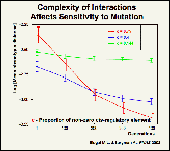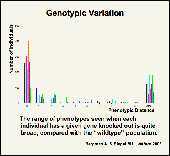Causes of Robustness

Most species maintain abundant genetic variation and experience a range of environmental conditions, yet phenotypic variation is low. That is, development is robust to changes in genotype and environment. It has been claimed that this robustness, termed canalization, evolves due to long-term natural selection for optimal phenotypes. We show that the developmental process, modeled as a network of interacting transcriptional regulators, constrains the genetic system to produce canalization, even without selection toward an optimum. The extent of canalization, measured as the insensitivity to mutation of a network's equilibrium state, depends on the complexity of the network, such that more highly connected networks evolve to be more canalized. We argue that canalization may be an inevitable consequence of complex developmental-genetic processes, and thus requires no explanation in terms of evolution to suppress phenotypic variation.
Consequences of Robustness

The molecular chaperone Hsp90 has been termed an 'evolutionary capacitor' because it has been shown, in Drosophila and Arabidopsis, to: 1) suppress phenotypic variation under normal conditions and release this variation when functionally compromised, 2) have its function overwhelmed by environmental stress, and 3) exert pleiotropic effects on key developmental processes. There is considerable debate whether these properties necessarily make Hsp90 a significant and unique facilitator of adaptation. Using numerical simulations of complex gene networks, as well as genome-scale expression data from yeast single-gene deletion strains, we study a novel mechanism that extends the scope of evolutionary capacitance well beyond the action of Hsp90 alone. We illustrate that most, perhaps all, genes reveal phenotypic variation when functionally compromised.We also show, in the first demonstration of the plausibility of evolutionary capacitance, that the availability of loss-of-function mutations speeds adaptation to a new optimum phenotype. However, this effect does not require the mutations to be conditional on the environment. Thus, there may exist a large class of evolutionary capacitors whose effects on phenotypic variation complement the systemic, environment-induced effects of Hsp90.